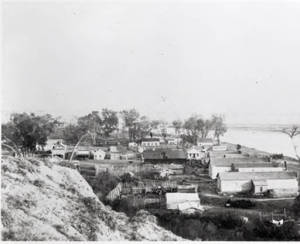Despite having died rather quietly (deserving only a single line in the newspaper when the last person left in 1909), Junction City, Montana had lived a busy and important life along the banks of the Yellowstone River. Its beginnings were rather meager, with trappers coming from the mountains to trade with the Indians at the location that would eventually spring up to be Junction City. It was in 1877 when Paul McCormick and a Major Pease arrived there and opened a merchandise store that would be run by the Major (as Paul had a business to tend to in Miles City) that the area began to thrive.
Perhaps that had been a good foresight by Mr. McCormick, since after the Battle of the Little Bighorn, forts (Fort Custer, Fort McGinnis, Fort McKinney) had become a more common sight in that part of Montana. The forts, needing supplies, brought steamboat travel upon the Yellowstone, and the area where Junction City came into being was usually as far upriver as they could get. So a landing was built there for Fort Custer by General Terry, giving the location its first name, Terry’s Landing.
However, across the river on the north side, Junction City was quickly growing and, by 1878, become home to the outfitters who supplied the north and northwest country and, eventually, the south as well. Having seen the rapid development of the area, Mr. McCormick closed shop in Miles City and moved to Junction City to continue in the merchandising business there. He became one of the leading citizens there as he had also become involved with freighting operations and held some important government freighting contracts.
By 1880 the population had grown to 41, and with the development of cattle country and the soon to come railroad, the population swelled to 300, and by 1883, 500. At one point, Junction City boasted fourteen saloons, three dance halls, blacksmith shops, several stores and other businesses, a ferry, and, of course, the houses of its residents. Early on it was a town where there were no lawmen save for when the people took up against something or someone bad, but it was not a bad place. Gun play was common there, but only resulted in one death. Eventually there came to be sheriffs at Junction, an early one being H.L. ‘Buckskin’ Williams and later on a deputy sheriff, Frank McCormick (who would not wear a gun because he was afraid that his bad temper would lead him to kill someone), who is said to have chased a band of horse thieves to the Canadian border, caught them and brought them to Billings to be put in jail…all without a gun!
With the arrival of the railroad, just south of town, in 1882, steamboats were no longer needed. The last steamboat to have been in the area (as it did not land at Junction City) was the Bachelor, which wintered twelve miles downriver, at Pease Bottom.
In 1883 there was a fire that destroyed a few saloons and a store. Since there was no equipment to fight a fire with, a bucket line was formed to the river. With every third bucket of water came a jug of whiskey and a quick drink would be taken. A prominent businessman, visiting from Billings, said that after the fire there were only five sober men in town!
The real beginning of the end for Junction City was the loss of the steamboats, though it remained an important and vibrant town for many years after. The role of the railroad tracks not coming to the town, instead being about a mile south, may have also eventually factored in to Junction City’s decline, as well as the floods that happen along the Yellowstone River. The final blow came when the final ‘ceded strip’ of Crow Indian land was opened up to settling.
On the bluffs above the old town site, which is about a mile and a half north of present day Custer, there is the Junction City graveyard (which, unfortunately, has been divided by a gravel road so all the graves are probably not there now). As I recall, there are two or three to be seen on the right side of the road and about three or four more around a bend on the left (those have been fenced in and graves are marked with whitewashed stones). Known to be buried there are a stage driver, a Negro boy named Andy, several soldiers from Fort Custer and others…either passers by or town residents.
In the 1930s there were still a few buildings left at the town site, but these (even by the time I became acquainted with the area in the late 1970s) are gone, having either been used in the town of Custer or washed away by the river. With difficulty, a sharp eye can see where the main street (running east/west in front of the river) was. There is a grade that runs down into the main street, which was separated from the river by a line of cottonwood trees, from the bluffs.
Submitted by: Ben Dodson |

McCormick store
Courtesy Ben Dodson

Junction City
Courtesy Ben Dodson
|